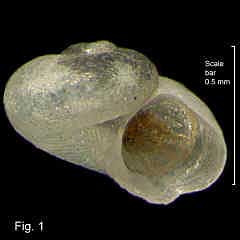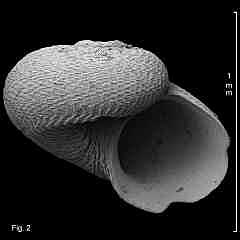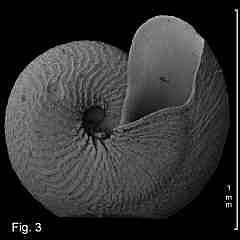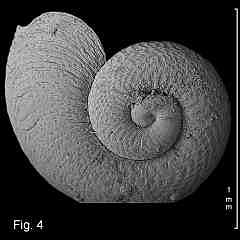|
|
|
|
|
Zalipais inscriptum (Tate, 1899) Description: Shell minute, spire a little raised, height to width ratio about 0.6 - 0.7. Protoconch initially pustulose then smooth, low, apex sunken. Teleoconch up to 1¾ whorls, suture deep. Surface with complex sculptural pattern, dominated by axial riblets that follow curve of outer lip, usually stronger on base, variable between specimens from strong to barely detectable. Umbilicus open, fairly narrow. Aperture with margin entire, outer lip thin, with shallow V-shaped sinus at periphery and another at bottom of aperture. Shell colourless transparent when fresh, becoming opaque white with age. Size: Up to 1.3 mm wide, 0.9 mm high. Distribution: Endemic to Australia. Port Stephens, NSW, southwards and around southern Australia to south-western WA. Habitat: In the Australian Museum collection, specimens are recorded as empty shells from beach washup, and alive from algae and rock washings from the low intertidal down to 14 m. Cotton (1959) lists live taken specimens down to 49 fathoms (89 m), but it is not clear that he is referring to the same species. Common. Comparison: This is a distinctive species, characterised by the shape of the outer lip and the wavy axial sculpture. Without either of these characters it is similar in form to Cirsonella reflecta. Synonymy: Zalipais laseroni Kershaw, 1955, (originally as Z. lissa Suter, 1908) from Tasmania, is probably this species. Remarks: Under the light microscope the sculpture appears as wavy axial ribs, usually stronger on the base, but SEM photos reveal a complex patterned surface. Fig. 1: Wimbie Beach, Batemans Bay, NSW (C.77973) Figs. 2,3,4: Boat Harbour, Cronulla, NSW (C.463019) (Photos Sue Lindsay, Australian Museum) |



